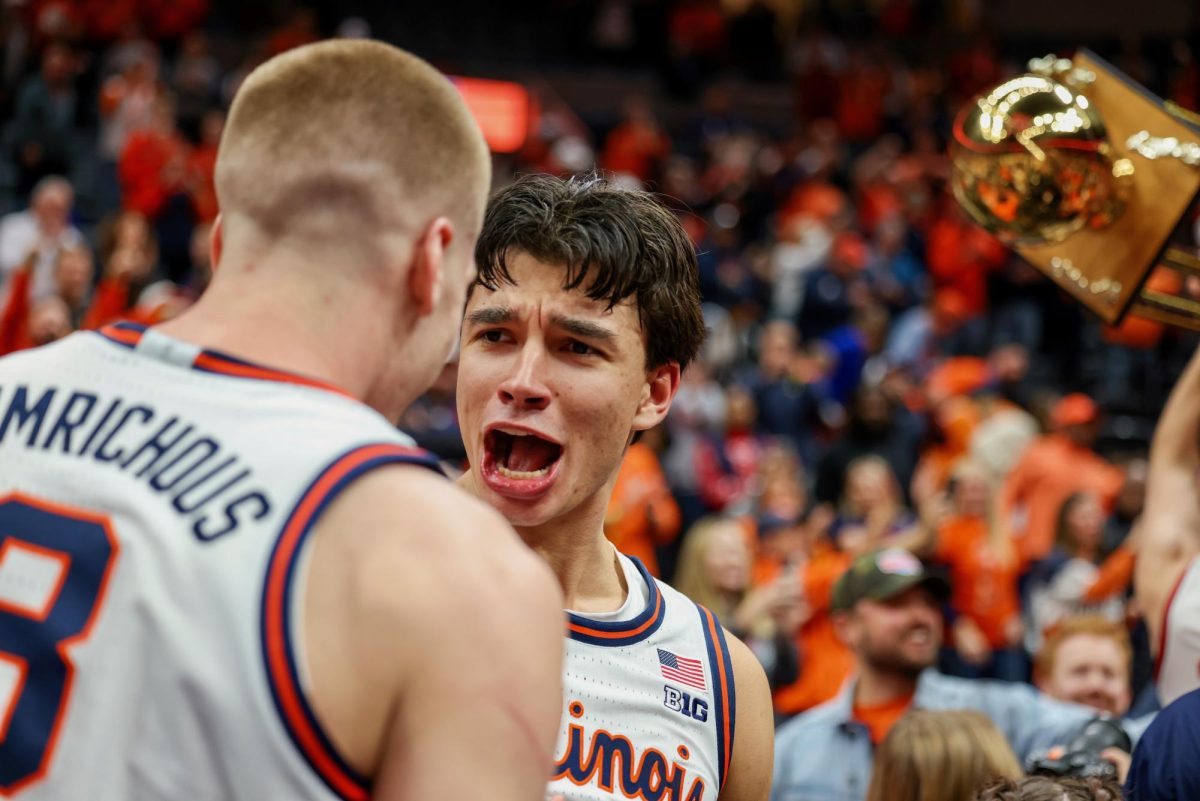It’s time for part two of the Big Ten fight songs. Featuring some of the conference’s oldest and newest members, the history behind all nine of these schools’ traditional tunes is rich.
Ohio State: “Buckeye Battle Cry”
In 1919, Ohio State was in search of a new fight song. After receiving numerous submissions, they chose “Buckeye Battle Cry” by Frank Crumit; it has remained a staple ever since. Notably, it is the fastest fight song in the Big Ten. The school’s marching band delivers an impressive halftime performance of this classic song, energizing fans and players alike.
Oregon: “Mighty Oregon”
“Mighty Oregon” became the Ducks’ fight song after it was created in 1915 by Albert John Perfect and DeWitt Gilbert. Perfect, the band director at the time, and Gilbert, a journalism student, adapted the song from the popular World War I march, “It’s a Long Way to Tipperary,” which was released in 1912.
Get The Daily Illini in your inbox!
Interestingly, “Mighty Oregon” almost didn’t happen, as the unofficial fight song “The Toast to Oregon” was popular before its debut. However, fans and the school embraced the fun and upbeat tune, making it the official fight song in 1916.
Now played by the Oregon Marching Band at every home game and major event, “Mighty Oregon” symbolizes the loyalty and spirit of Oregon fans.
Penn State: “Fight On, State”
“Fight On, State” has rallied Penn State fans for years. Created in 1915 by alum Joseph Saunders and a group of students, the song was born out of a desire to replace the previous fight song that lacked excitement. As a classic college football anthem, it fits a school with such a profound history in the sport. The famous line “Victory we predict for thee” embodies Penn State’s ambition for greatness and sustained success.
The energetic song enhances the excitement of Penn State’s iconic “White Out,” where fans dress in all white to create an electric atmosphere that reflects the passion and loyalty of Penn State supporters.
Purdue: “Hail Purdue”
In 1912, the writer for “Hail Purdue” at the time, James Morrison, asked the school’s Glee Club president if they could transform the words into music. It’s a brass-heavy and fast-paced song that fans can easily sing along with.
Interestingly enough, one of Purdue’s staple slogans, “Boiler Up,” is not included in the song. The song has been a rallying cry of late for Purdue’s successful basketball program and continues to support each program in West Lafayette.
Rutgers: “The Bells Must Ring”
Implemented in 1931 after a student song contest, Richard M. Hadden composed the song with W. E. Sanford. “The Bells Must Ring” refers to the bells in the famous Rutgers Old Queens Tower that have been a symbol of the school since 1766.
The last two lines read, “The bells of Queens each victory shout/ The bells of Queens must ring tonight,” representing the joy fans have for victory and the school spirit that the bells represent.
UCLA: “The Sons of Westwood”
Stolen from rivals? That’s what UCLA did with “The Sons of Westwood.” Harold Williams wrote the original song “Big C” in 1913. The original intention of the song was for the University of California Berkeley.
Sometime between 1940 and 1960, UCLA adopted the song from Cal and changed the lyrics to fit UCLA. An angry rage from Cal fans followed. The school was involved in multiple legal battles regarding the song’s ownership, but it was eventually named a public domain and not copyright. UCLA has used it as their official song ever since.
USC: “Fight On”
Another iconic fight song from a new addition to the Big Ten is “Fight On.” It’s hard not to think of the great USC athletes when listening to this song. Reggie Bush, Marcus Allen and Caleb Williams went to battle listening to this tune.
The song was created by then-dental student Milo Sweet in 1922 in a student competition, and it has become a legendary song ever since. In 1974, in a game versus arch-nemesis Notre Dame, USC was down 24-6 at halftime. With things looking bleak, the band played “Fight On” all game relentlessly. USC came back and won 55-24 in stunning fashion.
It continued its legendary run when World War II troops listened to it during their time in the Pacific for encouragement. The song has a deeper meaning of never giving up that resonates with many. It is a powerful and hopeful song, not just for Trojans but for everyone around the world.
Washington: “Bow Down to Washington”
In another competition for a new fight song, Lester J. Wilson took home the prize with his work “Bow Down to Washington.” Wilson was paid just $25 at the time for his services. In its debut game against California, Washington pulled a 72-0 win on the road. The team also headed to an undefeated 7-0 in the 1915 season.
It is still played over 100 years later and was especially key for Washington’s Sugar Bowl win and National Championship appearance earlier this year. It’s a passionate tune that illustrates Washington’s deep love for the state and university.
Wisconsin: “On, Wisconsin!”
One of the most well-regarded fight songs of all time, “On, Wisconsin!” was supposed to be called “Minnesota, Minnesota” and submitted to a student competition at Minnesota for a new fight song. A Wisconsin alum eventually convinced the student, William Purdy, to withdraw from the competition.
Afterward, the song was remade with Wisconsin lyrics and has become one of the greatest fight songs ever. It is now more than a fight song, as it became the official state song as well.






